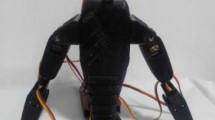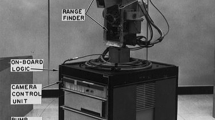Abstract
Based on terminal sliding mode control, a finite time tracking control scheme, which utilize the advantage of fast terminal sliding mode control and neural network, is presented for robot manipulators. A modified form of sliding surface is considered by introducing two nonlinear terms in the sliding surface. Then a novel robust control scheme is proposed, which shows the strong robustness towards uncertainties and disturbance and as a result the finite time convergence of the tracking error is achieved. The radial basis function neural network is utilized to estimate the nonlinearity of the robot dynamics using update laws. Furthermore the adaptive compensator eliminates the need of knowledge about the upper bound of external disturbances and neural network reconstruction error. The numerical simulation result shows the effectiveness of proposed controller for the case of microbot type robot manipulator in a comparative manner.









Similar content being viewed by others
References
Song Z, Yi J, Zhao D, Li X (2005) A computed torque controller for uncertain robotic manipulator systems. Fuzzy Sets Syst 154:208–260
Lewis FL, Dawson DM, Abadallah CT (2004) Robot manipulator and control. Taylor & Francis, London
Choi HS (2001) Robust control of robot manipulators with torque saturation using fuzzy logic. Robotica 19(6):631–639
Slotine JJE (1985) The robust control of robot manipulators. Int J Robot Res 4(4):49–64
Slotine JJE, Li W (1987) On the adaptive control of robot manipulators. Int J Robot Res 6(3):49–59
Bailey E, Arapostathis A (1987) Simple sliding mode control applied to robot manipulators. Int J Control 25(4):1197–1209
Capisani LM, Ferrara A (2012) Trajectory planning and second-order sliding mode motion/interaction control for robot manipulators in unknown environments. IEEE Trans Ind Electron 59(8):3189–3198
Moldoveanu F (2014) Sliding mode controller design for robot manipulators. Bull Transilv Univ Brasov 7(2):97–104
Edwards C, Spurgeon SK (1998) Sliding mode control theory and applications. Taylor & Francis, London
Lanzon A, Richards RJ (1999) Trajectory/force control of robot manipulators using sliding mode and adaptive control. In: Proceedings of the American control conference (San), vol 3, pp 1940–1944
Tan C, Yu XH, Man ZH (2010) Terminal sliding mode observers for a class of nonlinear systems. Automatica 46(8):1401–1404
Tang Y (1998) Terminal sliding mode control for rigid robots. Automatica 34(1):51–56
Mu C, Xu W, Sun C (2016) On switching manifold design for terminal sliding mode control. J Frankl Inst 353(7):1553–1572
Zhao D, Li S, Gao F (2009) A new terminal sliding mode control for robotic manipulators. Int J Control 82(10):1804–1813
Yu XH, Man ZH (2002) Fast terminal sliding-mode control design for nonlinear systems. Circuits Syst I Fundam Theory 49(2):261–264
Lewis FL, Jagannathan S, Yesilidirek A (1999) Neural network control of robot manipulators and nonlinear systems. Taylor & Francis, London
Panwar V, Kumar N, Sukavanam N, Borm JH (2012) Adaptive neural controller for cooperative multiple robot manipulator system manipulating a single rigid object. Appl Soft Comput 12:216–227
Kim J, Kumar N, Panwar V, Borm JH, Chai J (2012) Adaptive neural controller for visual serving of robot manipulators with camera-in-hand configuration. J Mech Sci Technol 26(8):2313–2323
Kumar N, Borm JH, Panwar V, Chai J (2012) Tracking control of redundant robot manipulators using RBF neural network and an adaptive bound on disturbances. Int J Precis Eng Manuf 13:1377–1386
Kumar N, Borm JH, Panwar V, Chai J (2014) Enhancing precision performance of trajectory tracking controller for robot manipulators using RBFNN and adaptive bound. Appl Math Comput 231:320–328
Wang L, Chai T, Zhai L (2009) Neural-network-based terminal sliding-mode control of robotic manipulators including actuator dynamics. IEEE Trans Ind Electron 56(9):3296–3304
Mahjoub M, Mnif F, Derbel N, Hamerlain M (2014) Radial-basis-functions neural network sliding mode control for underactuated mechanical systems. Int J Dyn Control 2(4):533–541
Rahmani M, Ghanbari A, Ettefagh MM (2016) Hybrid neural network fractional integral terminal sliding mode control of an Inchworm robot manipulator. Mech Syst Signal Process 80:117–136
Panwar V (2017) Wavelet neural network-based \(H_{\infty }\) trajectory tracking for robot manipulators using fast terminal sliding mode control. Robotica 35(7):1488–1503
Tran M, Kang H (2017) Adaptive terminal sliding mode control of uncertain robotic manipulators based on local approximation of a dynamic system. Neurocomputing 228:213–240
Bhat SP, Bernstein DS (2000) Finite-time stability of continuous autonomous systems. SIAM J Control Optim 38(3):751–766
Hong Y, Huang J, Xu Y (2001) On an output finite-time stabilization problem. IEEE Trans Autom Control 46(2):305–309
Abramowitch M, Stegun IA (1972) Handbook of mathematical fuctions: with formulas, graphs, mathematica tables. Dover, New York
Yu S, Yu X, Shirinzadeh B, Man Z (2005) Continuous finite-time control for robotic manipulators with terminal sliding mode. Automatica 41(11):1957–1964
Horn R, Johnson C (2013) Matrix analysis. Cambridge University Press, New York
Bhat SP, Bernstein DS (1997) Finite-time stability of homogeneous systems. Proc Am Control Conf 21(3):2513–2514
Yang L, Yang J (2011) Nonsingular fast terminal sliding-mode control for nonlinear dynamical systems. Int J Robust Nonlinear Control 21(11):1865–1879
Park J, Sandberg JW (1991) Universal approximation using radial-basis function networks. Neural Comput 3:246–257
Feng G, Chak CK (1994) Robot tracking in task space using neural networks. In: Proceedings of the IEEE conference on neural networks, pp 2854–2858
Holcomb T, Morari M (1991) Local training of radial basis function networks: towards solving the hidden unit problem. In: Proceedings of American control conference, pp 2331–2336
Wolovich W (1987) Robotics: basic analysis and design. Rinehart and Winston, St. Louis
Acknowledgements
This work is financially supported by the University Grants Commission(UGC) Sr. No. 2121340972 with Ref No. 22/12/2013 (ii) EU-V, New Delhi, India.
Author information
Authors and Affiliations
Corresponding author
Rights and permissions
About this article
Cite this article
Ruchika, Kumar, N. Finite time control scheme for robot manipulators using fast terminal sliding mode control and RBFNN. Int. J. Dynam. Control 7, 758–766 (2019). https://doi.org/10.1007/s40435-018-0477-0
Received:
Revised:
Accepted:
Published:
Issue Date:
DOI: https://doi.org/10.1007/s40435-018-0477-0




